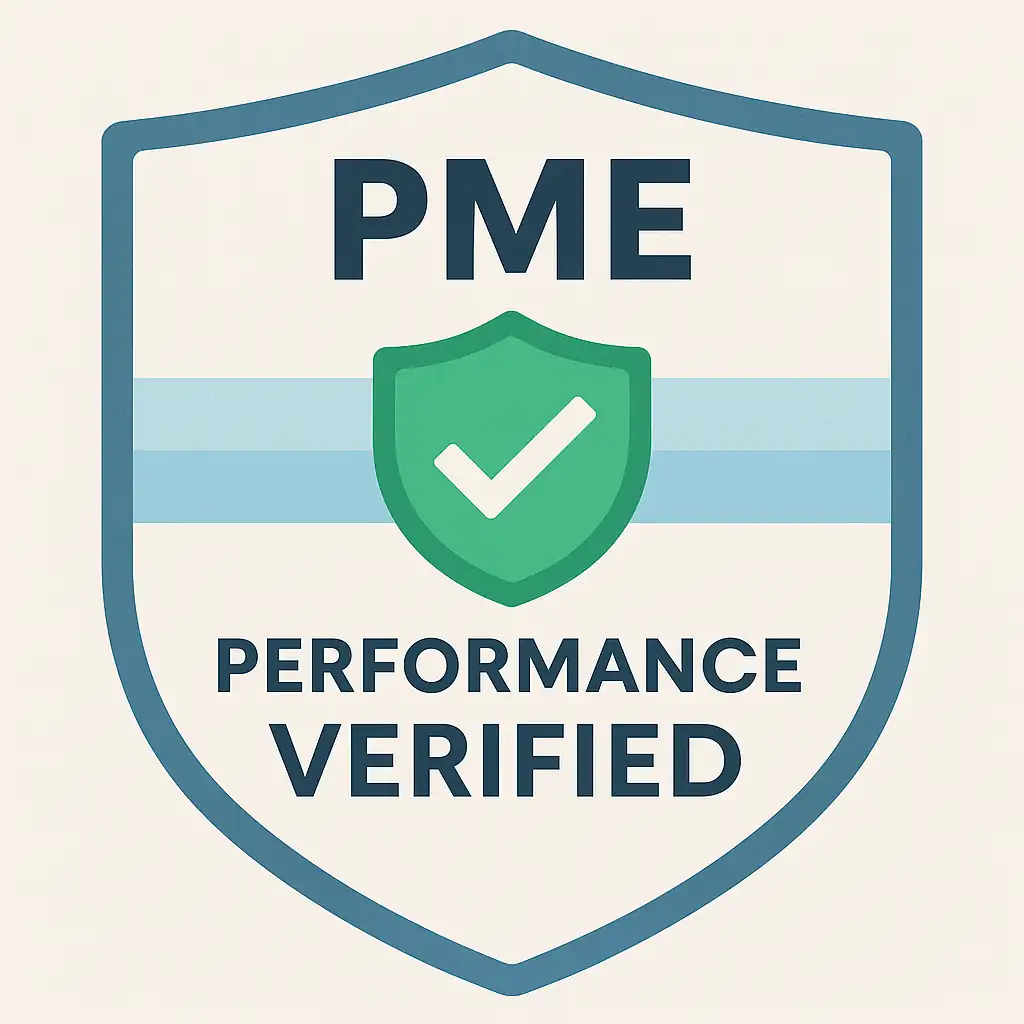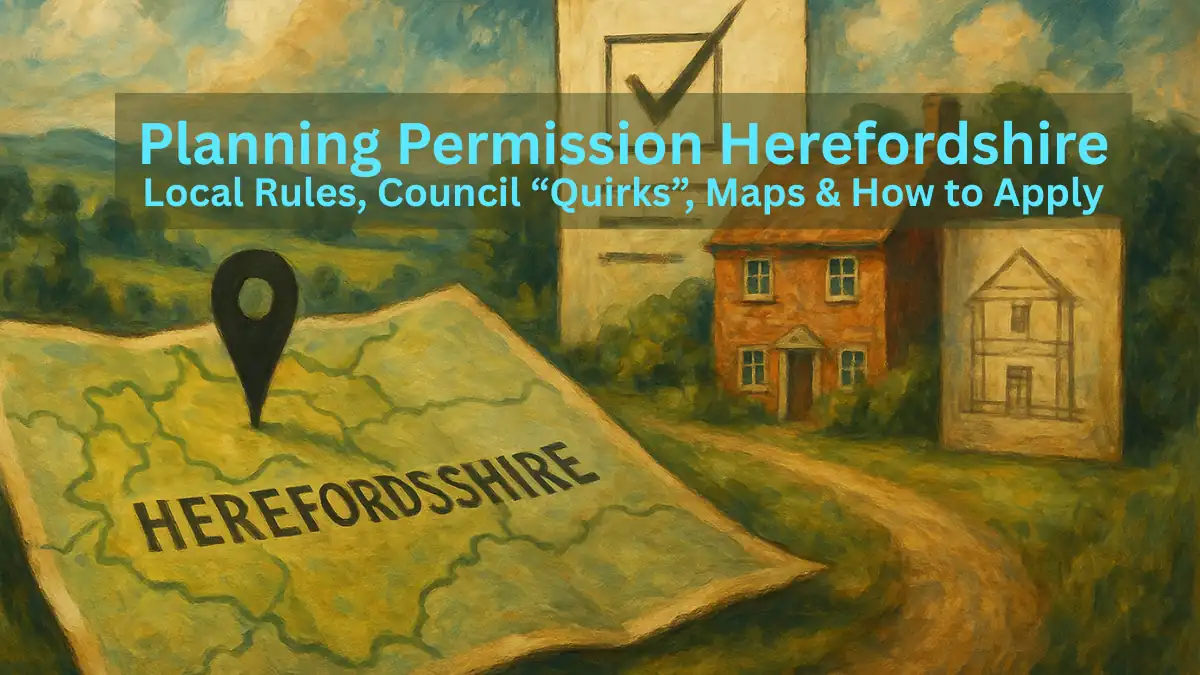Share this post:
🎥 Watch: 5 PROVEN Tips to Planning Permission Herefordshire
Prefer to watch instead of read? Here’s our quick 3-minute guide on Tips to Planning Permission Herefordshire👇Planning a project in Herefordshire?
We help homeowners navigate Herefordshire Council policy, PD rules, maps and approvals — without delays.
LOCAL GUIDE • HEREFORDSHIRE
Start here if you’re planning an extension, loft, garden room, garage conversion or new access in Herefordshire (including Hereford, Ross-on-Wye, Leominster, Ledbury, Bromyard & Kington). This guide shows you what to check, how to apply, and the council “gotchas” that commonly trip projects up.
Planning Permission Herefordshire — quick overview
Herefordshire Council is the local planning authority. Most small projects fall under Permitted Development (PD) if design limits are respected. If your home is in a conservation area, near a listed building, within the Wye Valley AONB (or close to the Malvern Hills AONB boundary), or if you live in a flat/maisonette, you are more likely to need a full application.
- Local authority: Herefordshire Council (planning applications and policy)
- Applies to: Hereford city and wider county settlements/towns
- Policy influence: conservation, design quality, access/parking, flood risk, trees/hedgerows, drainage (including build-over sewers)
What needs permission vs Permitted Development in Herefordshire
Many householder works can proceed without a full application if they meet PD limits. When PD won’t apply, a Householder Planning Application (or Prior Approval) is required.
Often Permitted Development (subject to limits):
- Single-storey rear extensions within height/depth limits
- Loft conversions & rear dormers within volume limits; rooflights to front are usually fine
- Outbuildings/garden rooms within size/position rules
- Porches up to PD thresholds
Usually needs permission:
- Extensions facing the highway beyond PD limits or on principal elevations
- Works in conservation areas that exceed stricter PD controls
- Flats/maisonettes (PD is very limited)
- Significant alterations in/near listed buildings
Useful background: Planning Portal — national guidance and GOV.UK — planning permission in England & Wales.
Deep-dive internal guides:
Herefordshire “quirks” & local design policies
- Conservation & setting: Many central Hereford streets and rural villages have tight character policies. Street-facing roof alterations and cladding changes are scrutinised.
- AONB edges: Projects in or near the Wye Valley AONB demand careful massing, materials and landscape impact statements.
- Drainage: Clay soils and private/shared sewers are common; build-over consents may be needed from the water company.
- Access & parking: Visibility splays on rural roads are a frequent validation query; provide clear drawings and photos.
Maps & constraints to check before you design
- Conservation Area / Listed status: Check council interactive maps and the National Heritage List.
- AONB: Confirm if you fall within the Wye Valley AONB or close to Malvern Hills boundaries.
- Flood risk: River Wye and tributaries affect parts of Hereford & Ross-on-Wye; add an FRA where necessary.
- Trees & hedgerows: TPOs are common; don’t omit tree constraints plans for extensions/outbuildings.
- Drains & sewers: Identify public/shared lines; request asset maps and secure build-over approval if needed.
Not sure if your idea fits Permitted Development?
We’ll check your project against PD rules and let you know if you need a full planning application.
How to apply for planning in Herefordshire (step-by-step)
| Step | What you do | PME tip |
|---|---|---|
| 1) Initial checks | Confirm PD vs full permission; review conservation/AONB, flood, trees, sewers. | Use Planning Portal guidance + council maps. |
| 2) Measured survey | Capture accurate dimensions, floor levels & elevations. | Accuracy prevents redesigns and validation delays. |
| 3) Design & drawings | Prepare existing/proposed plans, elevations, sections and a block plan. | Cross-check against PD limits and neighbour amenity. |
| 4) Supporting notes | Heritage, design & access, drainage/build-over, tree constraints as required. | Tailor to local policies; don’t upload generic templates. |
| 5) Submit online | Apply via the Planning Portal; pay fees; validate. | Respond fast to validation requests to start the clock. |
| 6) Consultation | Neighbours/statutory bodies comment; case officer review. | Proactive clarifications can avoid refusal or conditions. |
| 7) Decision | Target 8 weeks for householder applications. | Condition discharge may be needed before you build. |
After approval, move on to Building Control and gather your Certificates & Compliance Documents.
Fees, costs & timescales in Herefordshire
- Application fee: Standard householder fee (via Planning Portal) + service charge.
- Drawings & submission: See our guide to extension costs for typical design budgets.
- Extras: Heritage/tree notes, drainage or flood reports if requested.
- Timescale: Validation 1–2 weeks; decision ~8 weeks once validated.
Complex cases (heritage, AONB, neighbour issues) may extend beyond 8 weeks. Build time into your programme for any conditions to be discharged.
Common refusal reasons in Herefordshire (and how to avoid them)
- Overbearing or overlooking to neighbours — manage window placement, heights and set-backs.
- Poor design in conservation areas — use sympathetic materials and proportions; include a heritage rationale.
- Highways/parking concerns — show swept paths/visibility splays if access changes.
- Insufficient drainage detail — clarify soakaways, SUDS and any build-over consents.
FAQs — Planning Permission in Herefordshire
How do I view current planning applications in Hereford/Herefordshire?
Use the council’s online planning search to view live and decided applications. Filter by address, parish, date or status. For context, read officer reports and neighbour comments to understand why schemes succeed or fail.
What is Herefordshire Council planning policy for extensions?
Expect policies on neighbourhood character, scale, materials, access/parking and landscape impact. In conservation areas or AONBs, design quality and heritage impact are decisive. Provide a short Design & Access/Heritage Statement explaining your approach.
Do I need permission or is it Permitted Development?
Many rear extensions, lofts and garden rooms are PD if they stay within height/volume/set-back rules and the site isn’t constrained. Flats/maisonettes don’t benefit in the same way. We can check your drawings against PD quickly.
How long does a householder application take?
Typically ~8 weeks from validation. Allow 1–2 weeks for validation itself. Add time for reports, amendments or conditions if requested.
Where can I find land with planning permission in Herefordshire?
Search property portals and local agents; also review the council planning search for plots with recent approvals that haven’t been built. Always confirm conditions and expiry dates before you buy.
Can I build over or near sewers in Herefordshire?
Yes, but you’ll usually need a build-over agreement from the water company for public/shared sewers. Provide drainage plans with exact pipe positions and depths.
What happens after approval?
Move to Building Regulations drawings and structural design, then notify Building Control. See: Building Control Inspections — What to Expect and keep your Certificates & Compliance Documents organised for sign-off.
Conclusion — simpler approvals, better outcomes
Strong planning outcomes in Herefordshire come from early constraint checks, policy-aware design and clear supporting notes. If you align drawings with local character and neighbour amenity — and handle drainage/heritage correctly — approvals are very achievable.
Ready to move your project forward?
Plans Made Easy can prepare compliant plans, manage submissions, and guide you from idea to approval.
Next steps & useful guides
- Planning Permission (UK): Complete Homeowner’s Guide
- House Extensions — Complete UK Guide
- Loft Conversions — Costs, PD Rules & Process
- Planning Permission for a Garden Room
- Building Control Inspections
- Certificates & Compliance Documents
- Extension Costs — Homeowner’s Guide
- Building Over Sewers — What You Must Know
External references for authority:

Performance Verified ✅
This page meets PME Optimisation Standards — achieving 95+ Desktop and 85+ Mobile PageSpeed benchmarks. Verified on


